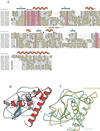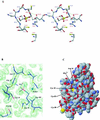Bacillus subtilis arsenate reductase is structurally and functionally similar to low molecular weight protein tyrosine phosphatases
- PMID: 11698660
- PMCID: PMC61083
- DOI: 10.1073/pnas.241397198
Bacillus subtilis arsenate reductase is structurally and functionally similar to low molecular weight protein tyrosine phosphatases
Abstract
Arsenate is an abundant oxyanion that, because of its ability to mimic the phosphate group, is toxic to cells. Arsenate reductase (EC; encoded by the arsC gene in bacteria) participates to achieve arsenate resistance in both prokaryotes and yeast by reducing arsenate to arsenite; the arsenite is then exported by a specific transporter. The crystal structure of Bacillus subtilis arsenate reductase in the reduced form with a bound sulfate ion in its active site is solved at 1.6-A resolution. Significant structural similarity is seen between arsenate reductase and bovine low molecular weight protein tyrosine phosphatase, despite very low sequence identity. The similarity is especially high between their active sites. It is further confirmed that this structural homology is relevant functionally by showing the phosphatase activity of the arsenate reductase in vitro. Thus, we can understand the arsenate reduction in the light of low molecular weight protein tyrosine phosphatase mechanism and also explain the catalytic roles of essential residues such as Cys-10, Cys-82, Cys-89, Arg-16, and Asp-105. A "triple cysteine redox relay" is proposed for the arsenate reduction mechanism.
Figures



References
Publication types
MeSH terms
Substances
Associated data
- Actions
LinkOut - more resources
Full Text Sources
Molecular Biology Databases

